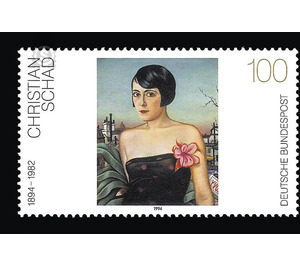German painting of the 20th century (3) - Germany / Federal Republic of Germany 1994 - 100 Pfennig
Theme: Art & Culture
| Country | Germany / Federal Republic of Germany |
| Issue Date | 1994 |
| Face Value | 100.00 |
| Color | multi-colored |
| Perforation | K 13 3/4: 14 |
| Printing Type | Multicolor offset printing |
| Stamp Type | Postage stamp |
| Item Type | Stamp |
| Chronological Issue Number | 1621 |
| Chronological Chapter | GER-BRD |
| SID | 389310 |
| In 51 Wishlists | |
The painting "Maika" (1929) by Christian Schad (1894-1982) seems far removed from comparable tendencies towards abstraction. Schad, who had moved from Vienna to Berlin in 1928, shows his friend Maika, a starlet of the Tobis Film Company, rather with supercooled accuracy. In the fashionable appearance of the twenties, the young woman poses against the backdrop of a roofscape. In contrast to this artificial world of metropolitan nightlife are the vegetal-organic motifs: the infected flower on the evening gown, the tree buds protruding into the picture, and above all the broad-leaved plant from which the figure seems to grow up. Comparable portraits of women by Christian Schad from the twenties show similar combinations with floral still lifes. Woman is thus defined as a natural being directly exposed to the process of the transience of its beauty. Schad makes use of a nearly Old Master painting, which is characterized by an enormous coolness. With an almost dissecting view and in an almost empty room, the subjects are captured in Schad's portraits. This creates life-like portraits that nevertheless seem alien and disturbing to the viewer. (Text: Martina Padberg, M.A., Bonn)


